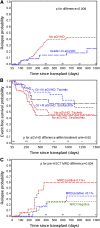The addition of sirolimus to tacrolimus/methotrexate GVHD prophylaxis in children with ALL: a phase 3 Children's Oncology Group/Pediatric Blood and Marrow Transplant Consortium trial
- PMID: 24497539
- PMCID: PMC3968388
- DOI: 10.1182/blood-2013-10-534297
The addition of sirolimus to tacrolimus/methotrexate GVHD prophylaxis in children with ALL: a phase 3 Children's Oncology Group/Pediatric Blood and Marrow Transplant Consortium trial
Abstract
Sirolimus has activity against acute lymphoblastic leukemia (ALL) in xenograft models and efficacy in preventing acute graft-versus-host disease (aGVHD). We tested whether addition of sirolimus to GVHD prophylaxis of children with ALL would decrease aGVHD and relapse. Patients were randomized to tacrolimus/methotrexate (standard) or tacrolimus/methotrexate/sirolimus (experimental). The study met futility rules for survival after enrolling 146 of 259 patients. Rate of Grade 2-4 aGVHD was 31% vs 18% (standard vs experimental, P = .04), however, grade 3-4 aGVHD was not different (13% vs 10%, P = .28). Rates of veno-occlusive disease (VOD) and thrombotic microangiopathy (TMA) were lower in the nonsirolimus arm (9% vs 21% VOD, P = .05; 1% vs 10% TMA, P = .06). At 2 years, event free survival (EFS) and overall survival (OS) were 56% vs 46%, and 65% vs 55% (standard vs experimental), respectively (P = .28 and .23). Multivariate analysis showed increased relapse risk in children with ≥0.1% minimal residual disease (MRD) pretransplant, and decreased risk in patients with grades 1-3 aGVHD (P = .04). Grades 1-3 aGVHD were associated with improved EFS (P = .02), whereas grade 4 aGVHD and extramedullary disease at diagnosis led to inferior OS. Although addition of sirolimus decreased aGVHD, survival was not improved. This study is registered with ClinicalTrials.gov as #NCT00382109.
Figures



References
-
- Eapen M, Raetz E, Zhang MJ, et al. Children’s Oncology Group; Center for International Blood and Marrow Transplant Research. Outcomes after HLA-matched sibling transplantation or chemotherapy in children with B-precursor acute lymphoblastic leukemia in a second remission: a collaborative study of the Children’s Oncology Group and the Center for International Blood and Marrow Transplant Research. Blood. 2006;107(12):4961–4967. - PMC - PubMed
-
- Borgmann A, von Stackelberg A, Hartmann R, et al. Berlin-Frankfurt-Münster Relapse Study Group. Unrelated donor stem cell transplantation compared with chemotherapy for children with acute lymphoblastic leukemia in a second remission: a matched-pair analysis. Blood. 2003;101(10):3835–3839. - PubMed
-
- Oliansky DM, Camitta B, Gaynon P, et al. Role of cytotoxic therapy with hematopoietic stem cell transplantation in the treatment of pediatric acute lymphoblastic leukemia: update of the 2005 evidence-based review [published correction appears in Biol Blood Marrow Transplant. 2012;18(9):1466]. Biol Blood Marrow Transplant. 2012. 18(4):505-522. - PubMed
-
- MacMillan ML, Davies SM, Nelson GO, et al. Twenty years of unrelated donor bone marrow transplantation for pediatric acute leukemia facilitated by the National Marrow Donor Program. Biol Blood Marrow Transplant. 2008;14(suppl 9):16–22. - PubMed
-
- Harvey J, Green A, Cornish J, et al. Improved survival in matched unrelated donor transplant for childhood ALL since the introduction of high-resolution matching at HLA class I and II. Bone Marrow Transplant. 2012;47(10):1294–1300. - PubMed
Publication types
MeSH terms
Substances
Associated data
Grants and funding
LinkOut - more resources
Full Text Sources
Other Literature Sources
Medical
Miscellaneous

